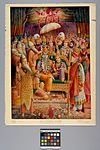About this object
History of use
Indian popular religious prints have been published for nearly a century, first by German presses, later by Indian ones. The prints may take the form of calendars, posters, or simply images. The style of the representations is European. In the beginning they were Hindu images, but are now acquiring elements both of folk art and a romantic secularism. It is a living art currently influenced by the movie industry and non-Hindu religions. The images are a vehicle for advertising and are also used for religious purposes. This print was produced, framed, and displayed in a prayer room for 'puja' or worship.
Narrative
Rama, the most perfect of princes, and his noble wife Sita portray the ideal couple by their acts of self-denial for the good of society. Popular episode is Rama's rescue of Sita from the ten-headed demon king, Ravana, with the help of Hanuman and Lakshmana.
Cultural context
popular religious art
Iconographic meaning
Rama, seventh incarnation of Vishnu, is identified by the presence of his ideal, loving wife, Sita, by his side; Vaishnavite 'u' on forehead; bow and arrow-filled quiver symbolizing masculine virtures; green-coloured skin; either dressed as a king or forest dweller; presence of Hanuman, half-human, half-monkey deity, often shown kneeling at Rama's feet; and presence of Rama's brother Lakshmana, also carrying an arrow-filled quiver.
Physical description
Rectangular print of a blue-skinned male, Rama, carrying a bow and quiver, seated with female, Sati, who wearing a purple sari. Both are seated on a green-cushioned, green and red jewel-encrusted gold throne. Kneeling at their feet is Hanuman. Another male behind throne shades the couple with white umbrella, while two others in gold crowns stand with him, one with a green face. White-haired and bearded males stand at side on left in crowd of males and females clustered behind throne. In foreground, two males stand flanking couple. All colours muted and have pink tone. Print entitled 'Sri Rama Pattabhishek'.
Categories
Materials
